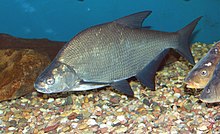
Back Weißfische German Blankfiŝoj Esperanto Leuciscinae Spanish قناتماهیان Persian Särjet (alaheimo) Finnish Leuciscinae French Leuciscinae Galician Leuciscinae Hungarian Leuciscinae Italian ウグイ亜科 Japanese
| Leuciscinae | |
|---|---|

| |
| Common bream, Abramis brama | |
| Scientific classification | |
| Domain: | Eukaryota |
| Kingdom: | Animalia |
| Phylum: | Chordata |
| Class: | Actinopterygii |
| Order: | Cypriniformes |
| Family: | Cyprinidae |
| Subfamily: | Leuciscinae Bonaparte, 1835 |
| Genera | |
|
See text | |
Leuciscinae is a subfamily of the freshwater fish family Cyprinidae,[1] which contains the true minnows.[2]
Members of the Old World (OW) clade of minnows within this subfamily are known as European minnows. As the name suggests, most members of the OW clade are found in Eurasia, aside from the golden shiner (Notemigonus crysoleucas), which is found in eastern North America.[3][4]
According to ancestral area reconstruction, the subfamily Leuiciscinae is thought to have originated in Europe before becoming widely distributed in parts of Europe, Asia and North America. Evidence for the dispersal of this subfamily can be marked by biogeographical scenarios/observations, geomorphological changes, phylogenetic relationships as well as evidence for vicariance events taking place through time.[5] Through analyses and evidence of divergence time, it was observed that the two monophyletic groups, the phoxinins and the leuciscins, had shared a common ancestor dating to approximately 70.7 million years ago, representing their lengthy evolutionary history.[6][7][a] The 5th edition of the Fishes of the World classifies the Leuciscinae as a subfamily of the Cyprinidae[1] but other classifications have resolved this taxon as a family, the Leuciscidae.[4]
- ^ a b J. S. Nelson; T. C. Grande; M. V. H. Wilson (2016). Fishes of the World (5th ed.). Wiley. pp. 181–186. ISBN 978-1-118-34233-6.
- ^ Taxonomic information
- ^ "Order CYPRINIFORMES: Family LEUCISCIDAE: Subfamilies PSEUDASPININAE, LEUCISCINAE and PHOXININAE". The ETYFish Project. 2018-10-17. Retrieved 2020-11-27.
- ^ a b Schönhuth, Susana; Vukić, Jasna; Šanda, Radek; Yang, Lei; Mayden, Richard L. (2018-10-01). "Phylogenetic relationships and classification of the Holarctic family Leuciscidae (Cypriniformes: Cyprinoidei)". Molecular Phylogenetics and Evolution. 127: 781–799. Bibcode:2018MolPE.127..781S. doi:10.1016/j.ympev.2018.06.026. ISSN 1055-7903. PMID 29913311. S2CID 49292104.
- ^ Imoto, J. M.; Saitoh, K.; Sasaki, T.; Yonezawa, T.; Adachi, J.; Kartavtsev, Y. P.; Miya, M.; Nishida, M.; Hanzawa, N. (2013). "Phylogeny and biogeography of highly diverged freshwater fish species (Leuciscinae, Cyprinidae, Teleostei) inferred from mitochondrial genome analysis". Gene. 514 (2): 112–124. doi:10.1016/j.gene.2012.10.019. PMID 23174367.
- ^ a b Perea, S.; Böhme, M.; Zupancic, P.; Freyhof, J.; Sanda, R.; Ozuluğ, M.; Abdoli, A.; Doadrio, I. (2010). "Phylogenetic relationships and biogeographical patterns in Circum-Mediterranean subfamily Leuciscinae (Teleostei, Cyprinidae) inferred from both mitochondrial and nuclear data". BMC Evolutionary Biology. 10 (1): 265. Bibcode:2010BMCEE..10..265P. doi:10.1186/1471-2148-10-265. PMC 2940817. PMID 20807419. S2CID 206970716.
- ^ "Order CYPRINIFORMES: Family LEUCISCIDAE: Subfamilies PSEUDASPININAE, LEUCISCINAE and PHOXININAE". The ETYFish Project. 2018-10-17. Retrieved 2020-11-26.
- ^ Schönhuth, Susana; Vukić, Jasna; Šanda, Radek; Yang, Lei; Mayden, Richard L. (2018-10-01). "Phylogenetic relationships and classification of the Holarctic family Leuciscidae (Cypriniformes: Cyprinoidei)". Molecular Phylogenetics and Evolution. 127: 781–799. Bibcode:2018MolPE.127..781S. doi:10.1016/j.ympev.2018.06.026. ISSN 1055-7903. PMID 29913311. S2CID 49292104.
Cite error: There are <ref group=lower-alpha> tags or {{efn}} templates on this page, but the references will not show without a {{reflist|group=lower-alpha}} template or {{notelist}} template (see the help page).